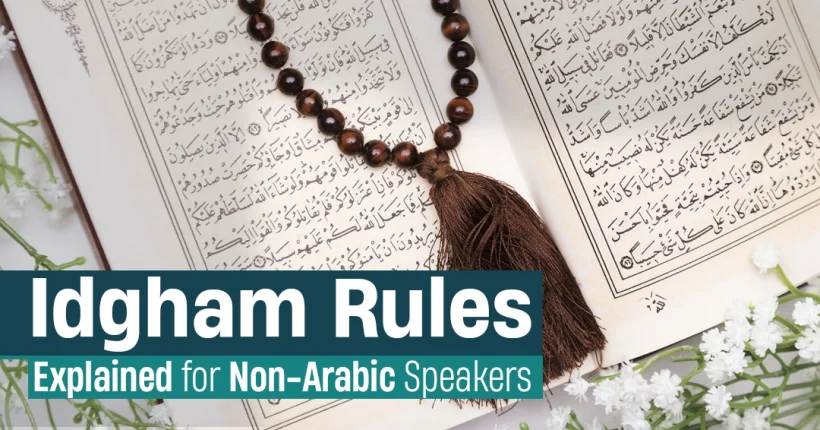Ever noticed that echo when you recite words like “Qul huwa Allahu Ahad” or “Wa tabbat yada”? That’s not a coincidence, it’s called Qalqalah, and it’s one of the most beautiful tajweed rules of qalqalah that adds rhythm, clarity, and power to your recitation.
The word Qalqalah literally means vibration or echo. It’s the gentle bounce you produce when pronouncing certain letters with clarity. Without it, your recitation sounds flat; with it, your words come alive, as if echoing through the heart.
Understanding the Essence of Tajweed
Before diving into the rules of qalqalah, let’s revisit what Tajweed itself means.
Tajweed comes from the Arabic root j-w-d, meaning to make better or improve. In Qur’an recitation, it’s all about articulating each letter from its correct point of origin (makhraj) and giving it its due right (sifaat).
Think of it as the “grammar of recitation.” Just as grammar makes writing clear, Tajweed makes your recitation pure and precise, exactly as the Prophet Muhammad ﷺ recited it.
What Is Qalqalah? The Science Behind the Echo
The qalqalah rule focus on five specific letters that produce a distinct echo-like sound when pronounced without a vowel (sukoon).
These letters are:
ق – ط – ب – ج – د
When one of these letters carries a sukoon (no vowel sound), it must be pronounced with a slight vibration or rebound of the sound, not from the throat, but from the letter’s point of articulation.
Imagine saying “Qul” without the echo, it feels abrupt. Now add that light vibration: “Qul!” That’s Qalqalah. It’s the sound that gives your recitation bounce and clarity, especially when ending verses.
The Linguistic Roots of Qalqalah
Linguistically, Qalqalah derives from the Arabic root (ق ل ق), meaning to shake or to move.
In Tajweed terminology, it signifies the movement of the sound at the articulation point due to sukoon, a controlled, rhythmic vibration that avoids harshness.
The scholars of Tajweed, such as Imam Ibn al-Jazari and Sheikh al-Qari al-Misri, have explained that Qalqalah prevents the letters from being swallowed or dropped when pronounced without vowels, preserving the clarity of Allah’s words.
The Five Qalqalah Letters and How to Recognize Them
Here’s your golden rule:
“Qutbu Jadd” (قطب جد), this phrase helps you remember the five Qalqalah letters.
The Five Letters:
Qaf (ق)
Taa (ط)
Baa (ب)
Jeem (ج)
Daal (د)
Each letter has a strong, clear articulation point. When pronounced with sukoon, they produce a soft echoing sound.
The Three Levels of Qalqalah: Minor, Medium, and Major
There are three levels of Qalqalah intensity depending on the position of the letter and whether it carries a shaddah (stress).
1. Qalqalah Sughra (Minor Qalqalah)
This Tajweed rules of Qalqalah occurs when the Qalqalah letter is in the middle of a word and carries a sukoon.
🕌 Example: يَقْطَعُونَ (yaqta‘oon)
The echo is soft, don’t exaggerate it.
2. Qalqalah Wusta (Medium Qalqalah)
Occurs when the Qalqalah letter is at the end of a word, and you stop (waqf) on it.
Example: الْحَقْ (al-Haqq)
Here, the echo is clearer and slightly stronger.
3. Qalqalah Kubra (Major Qalqalah)
Occurs when the Qalqalah letter has a shaddah (ّ) and you stop on it.
Example: تَبَّتْ (tabbat)
The sound is more pronounced, like a distinct bounce of energy.
Practical Application: Qalqalah Examples from the Quran
Understanding the rules is one thing, but hearing and practicing Qalqalah in real Quranic words is what truly solidifies your mastery. Below, we explore practical examples of the five Qalqalah letters, how they appear, and the level of echo you should apply.
1. Qaf (q) Examples
Verse: “Qad aflaha”
Explanation: The Qaf carries sukoon, so you apply a minor Qalqalah.
Tip: Pronounce it as “Qad” with a soft bounce, avoid adding vowels.
Verse: “Al-Haqq”
Explanation: Qaf appears at the end of a stop, medium Qalqalah.
Tip: Give a slightly stronger echo without exaggerating.
2. Taa (t) Examples
Verse: “Tabbat yada”
Explanation: Taa at the end has shaddah, so it is major Qalqalah.
Tip: Pronounce it with a pronounced but controlled bounce to avoid distortion.
Verse: “Wa qataloo”
Explanation: Taa in the middle, minor Qalqalah.
Tip: Keep it light and precise.
3. Baa (b) Examples
Verse: “Yubashshiru”
Explanation: Baa has sukoon in the middle of the word, minor Qalqalah.
Tip: Ensure the echo is subtle and does not merge with the following letters.
Verse: “Al-Kitab”
Explanation: Baa at the end of a stop, medium Qalqalah.
Tip: Let the sound rebound gently for clarity.
4. Jeem (j) Examples
Verse: “Jaa’oo”
Explanation: Jeem carries sukoon, minor Qalqalah.
Tip: A small bounce ensures it is audible without exaggeration.
Verse: “Al-Jalil”
Explanation: Jeem at the end of a stop, medium Qalqalah.
Tip: Focus on the clarity of the consonant.
5. Daal (d) Examples
Verse: “Qad aflaha”
Explanation: Daal at the end is a medium Qalqalah.
Tip: Pronounce with a clean echo to distinguish it from nearby letters.
Verse: “Wa tabbada”
Explanation: Daal with shaddah — major Qalqalah.
Tip: Give a noticeable yet controlled bounce.
Tips for Practicing Qalqalah with Quranic Examples
Start slowly: Read each word carefully, focusing on the Qalqalah letter.
Record yourself: Compare your pronunciation with recitations by expert Qaris.
Use repetition: Repetition builds muscle memory for each letter’s echo.
Stop and pause: Practicing Qalqalah at the end of verses helps strengthen medium and major Qalqalah.
Enroll in structured courses: Tareequl Jannah provide guided practice with live feedback, helping you perfect every Qalqalah letter.
When and How to Apply the Qalqalah Sound
Applying the tajweed rules of qalqalah correctly means balancing precision with naturalness.
Follow these steps:
Identify if the letter is one of the five Qalqalah letters.
Check if it carries a sukoon or if you are stopping at it.
Add the echo sound softly, avoid adding extra vowel or breath.
Listen to expert reciters like Sheikh Mishary Alafasy or Sheikh Husary to master tone control.
Remember: Qalqalah is not shouting or bouncing loudly, it’s a controlled vibration. A small, polished ripple, not a drumbeat!
Common Mistakes in Applying Qalqalah and How to Fix Them
Even experienced reciters stumble here. Some common mistakes when learning Tajweed rules of Qalqalah include:
Overemphasizing the echo, turning it into a new vowel.
Ignoring Qalqalah when the letter appears mid-word.
Misplacing breath, Qalqalah comes from articulation, not exhalation.
Lack of consistency, reciting with Qalqalah in one verse, skipping it in another.
Tip: Practice slow recitation with a certified Tajweed teacher from Tareequl Jannah to receive live feedback. Nothing replaces guided learning.
Practical Tips to Master Qalqalah in Tajweed
Here’s how to make Tajweed rules of Qalqalah your best recitation ally:
Start with isolated letters: say قْ, طْ, بْ, جْ, دْ with a mirror in front of you.
Move to Qur’anic examples: pick short surahs like Al-Ikhlas or Al-Masad.
Record yourself: it helps you hear mistakes you miss while reciting.
Use Tajweed flashcards: visual learning aids memory.
Enroll in Tareequl Jannah’s Tajweed Course: where certified instructors refine your recitation step-by-step.
Why Learning the Tajweed Rules of Qalqalah Online Is Easier Than You Think
Thanks to interactive platforms like Tareequl Jannah, learning the Tajweed rules of Qalqalah is more accessible than ever. With screen sharing, personalized sessions, and real-time correction, you can perfect your echo, even from your living room.
Many students testify that online learning gives them flexibility without compromising quality. The structured modules and feedback sessions make mastering Qalqalah smooth, engaging, and spiritually fulfilling.
How Tareequl Jannah Makes Tajweed Learning Accessible for Everyone
At Tareequl Jannah, our goal is simple:
To help you recite the Qur’an as it was revealed, with beauty, accuracy, and love.
Our Tajweed Courses include:
One-on-one live lessons with certified teachers.
Specialized sessions on tajweed rules of qalqalah and other articulation techniques.
Female instructors for sisters and flexible scheduling for busy learners.
Access to recorded materials, quizzes, and progress tracking.
Whether you’re a beginner or refining your recitation, Tareequl Jannah is your trusted companion in Qur’anic excellence.
FAQs About Qalqalah and Tajweed
Why is Qalqalah important in Tajweed?
It ensures clarity and beauty in pronunciation, maintaining the integrity of the Qur’anic text.
Can Qalqalah change the meaning if done incorrectly?
Yes. Mispronouncing Qalqalah may distort letter sounds, potentially altering meanings, which is why proper training is essential.
Is Qalqalah applied when the letter has a vowel?
No. Qalqalah occurs only when the letter has a sukoon (no vowel) or when you stop on it.
How can I practice Qalqalah daily?
Read short surahs aloud, focus on ending sounds, and compare your recitation to verified Qaris.
What’s the best way to learn Tajweed?
The most effective method is learning under a qualified teacher, like those at Tareequl Jannah, who can correct your articulation in real time.
Final Reflections: Your Journey Toward Perfect Recitation
Mastering the Tajweed rules of Qalqalah is like polishing a diamond, it takes patience, but the glow is eternal.
Every echo, every vibration, every crisp sound of Qaf, Jeem, or Daal brings you closer to the divine eloquence of the Qur’an.
Reciting beautifully is not just about sound, it’s about heart. When your pronunciation aligns with Tajweed, your recitation transforms into ibadah (worship).
Enroll Today and Start Perfecting Your Recitation
Ready to recite the Qur’an with confidence and clarity? Join Tareequl Jannah’s Online Tajweed Course today and master the Tajweed rules of Qalqalah with expert teachers who guide you every step of the way.
Because every letter you perfect brings you closer to Allah.





